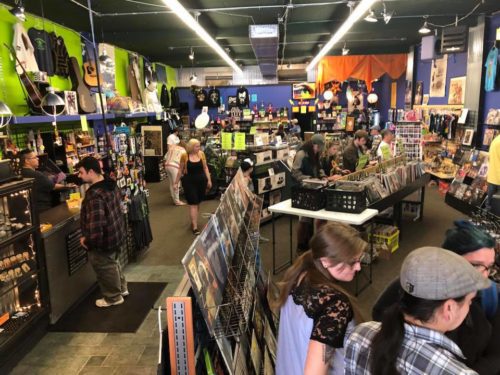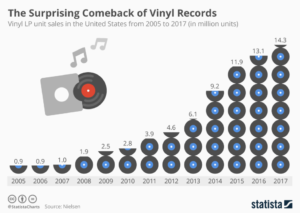
Record Store Day 2018. Photo Courtesy of In Your Ear Music Emporium.
Vinyl records may have been referred to as a thing of the past or something you would see at your local Goodwill, but not anymore. Now vinyl is back and here to stay.
This vinyl revival has existed since 2007 and has continued to show increased interest and sales. In 2017, digital downloads were outsold by physical albums. Vinyl sales increased by 10 percent from 2016 while CD sales decreased by 6 percent and digital downloads went down 25 percent.
Being the owner of Hardy Boys Records in Mint Hill, North Carolina, Dean Hardy knows one reason for the increased popularity is that people want something physical.
“It’s tactile. When you are listening to a record, you can look at the album art, read the lyrics, and get to know the band by looking at the pictures. You can also display them as well. You can’t do that with MP3’s,” said Hardy.
He also brought up his own perspective as a collector and what that means for buyers and sellers.
“When you add in the collector element, I think it gives records a shot-in-the arm. Some records weren’t pressed in high numbers, so there can be a huge demand and low supply,” said Hardy.
One of those records in Hardy’s possession is a sealed promotional copy of Guns N’ Roses 1987 debut album “Appetite For Destruction” with the original uncensored cover and a promotional gold foil stamp. The vinyl is also translucent when backlighted. According to Discogs, the highest the album has sold for is $308.09.

The rise of LP sales in the United States. Chart and data courtesy of Statista and Nielsen.
Hardy also compared this situation to the baseball card craze in the 70s and 80s. The difference being some of the artists throughout the late 1990s had low amounts of records pressed, if any at all, due to the increased use of CDs. This generation enjoys that era’s music, so it gives a reason as to why some of those records are priced high.
Since records are being priced high and record companies know there is a demand, they do reissue campaigns for popular artists every so often. This allows fans and collectors to buy certain albums on vinyl for a reasonable cost.
Record companies will sometimes reissue albums on 180 gram vinyl versus the usual 120 or 140. This is done to make the album stronger and resist warping. As a result, it is considered to be audiophile grade. They often reissue albums on double vinyl as well. This means an album will be stretched onto two units instead of the one. This is done so there is less compression, which affects the overall sound quality. Listeners are sometimes skeptical of reissues because the source of the music pressed may not be the original source, but the actual CD release. This information is not always disclosed to buyers.
Record Store Day is an annual event that began in 2008 and is recognized throughout the world. This was a response by record companies to the public’s increased interest. Jason McMahan is involved with the event as the owner of In Your Ear Music Emporium, located in Sylva, North Carolina.
“The record industry has been doing Record Store Day to celebrate independent record stores and doing that with vinyl, collector’s edition vinyl, limited release vinyl, never before on vinyl, picture discs. It’s only offered at independent shops across the country. It’s a fairly big event. I think that has stimulated some interest as well,” said McMahan.
The next Record Store Day is Friday, Nov. 23. More information on the event, participating locations and records that will be released can be found here.
McMahan also explained vinyl naturally sounds better than other forms of media due to vinyl being analog rather than digital. This is a main reason why people are coming back around to vinyl records.
“You’ve got a piece of vinyl, synthetic plastic that’s etched with soundwaves that moves the needle that gets turned into electrical impulses, which are good for your speakers. It’s basically capturing sound in a medium whereas CDs are ones and zeros written by a laser. It’s not the same. It’s also compressed so you’re losing a lot of your fidelity, frequencies,” explained McMahan.
Buying and listening to vinyl is an enjoyable hobby but doesn’t come without a hefty price. To play vinyl you need a turntable, receiver and speakers as the bare minimum. You can buy a system with all of these components or you can buy them separately. Prices for these can range from a few hundred dollars to a few thousand depending on your system preferences and budget. If you want to get started with vinyl or know more information, that can be found here.


